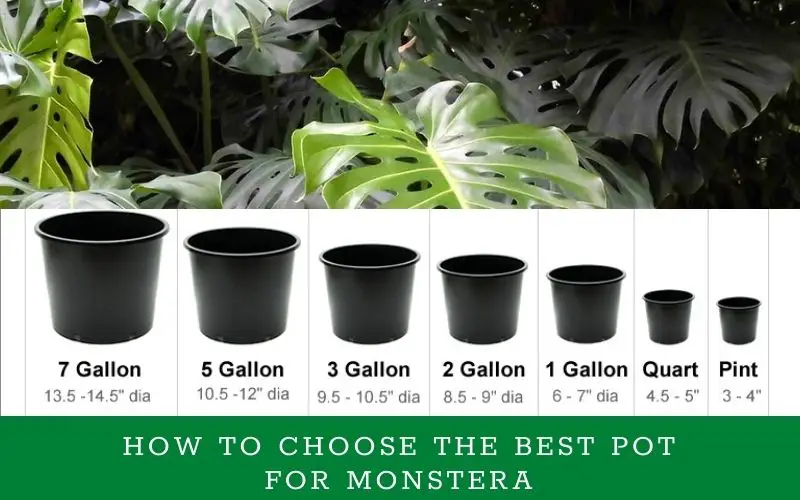Choosing the best pot for Monstera Deliciosa is the question of those interested in Monstera. Requirements to plant and taking care of trees is not an easy job because it requires a lot of knowledge and experience in planting.
However, buying a pot does need much technique, nor is it a factor that significantly affects the plant’s growth. But choosing the right pot is also a way to say how much you love taking care of your plants.
Which is the best pot for Monstera that should you use?
The most popular types of pots are made of terracotta, glazed ceramic, and plastic, which resemble nursery pots in appearance. Other than that, there are plenty of other options. Let’s take a closer look at them and weigh the pros and cons.
Plastic Pots
You can buy plants at a garden center or plant shop in a little plastic container. These pots, known as nursery pots, are perfectly adequate for growing Monstera; however, they tend not to be the most beautiful.
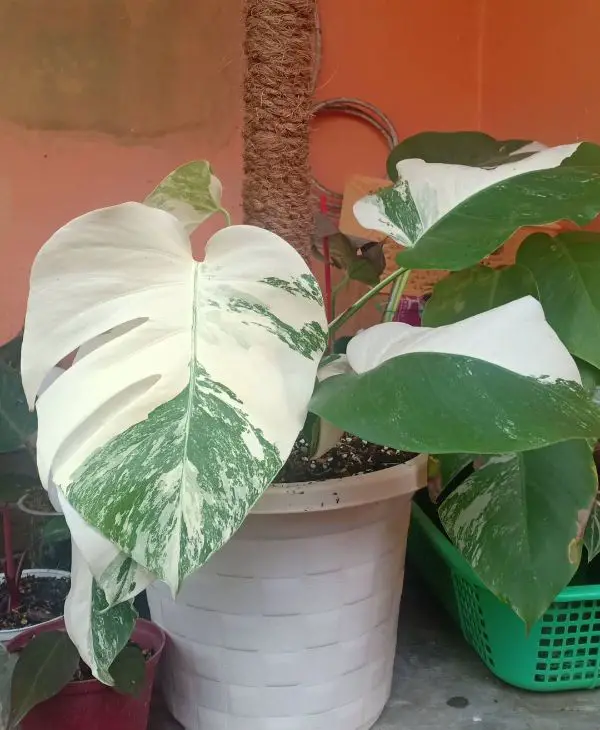
Pros:
- They are available in a variety of colors, making them easy to match your interior or outside décor
- Lightweight and highly adaptable
- They are resistant to fracture even when dropped
- The least expensive option
- Some of them are recyclable
Cons:
- Plastic pots will not draw water away, making them ideal for damp plants. They may, however, induce root rot in Monsteras
- They are small and provide minimal protection from heat or cold. Those that are black may overheat on hot summer days, affecting the roots of your plant
- Low-quality brands are subjected to UV damage, which causes them to fade by becoming brittle. Choose ones that have UV light inhibitors
- Cheaper versions are less enticing
Plastic pots are best used for double-potting with another type of pot. If you have another pot with no drainage holes, this is an excellent combination to utilize. A 3.5-inch plastic nursery pot, for example, can be placed inside a 4-inch pot of a different type, even one without holes. In this case, the outer pot is referred to as a cachepot.
This allows you to simply exchange plants and pots, enjoy the cache pot’s looks, and use the drainage holes in the plastic pot to keep water from seeping into your furniture. It’s a win-win-win situation!
You may even put the nursery pot inside a huge bag or basket for exceptionally large plants to save money on a giant pot while still complementing your interior design.
Terracotta pots
Your Monstera will thrive in terracotta pots. They are unglazed, fire-kilned clay pots created from a specific type of soil and are generally rusty red in color. Both indoor and outdoor Monstera plants are compatible with these pots.

Pros:
- It is porous, which means that moisture and air may travel through it. Roots close to the walls may benefit. Furthermore, the soil dries quickly as rainwater drains away, avoiding overwatering issues
- A terracotta container has a thick wall that can assist protect your plant from sudden temperature fluctuations, such as a hot day outside or cold. They might otherwise damage your plant
- It’s hefty, so it’ll stay erect even when the wind blows
- The moisture level may be determined by inspecting the wall. Where there is moisture, the hue changes
- Affordable
- Completely recyclable
Cons:
- If it falls or is knocked, it will fall swiftly. It may also be broken by frost
- As dissolved solids percolate to the surface, a white crust forms on the exterior. These yellowish crusts are unappealing to some individuals
- Increases the frequency of watering
- Molds may form on the outside of the container
- Disinfection takes a long period
Terracotta pots are ideal for those who overwater their plants since they drain moisture away from the soil, allowing them to dry quickly. You’ll also be able to assess moisture levels by looking at their colors or feeling them.
If you want to use it outside, it will help to protect roots from extreme temperature swings, especially in the summer.
It’s a perennial favorite since it prevents overwatering and root rot in your Monstera. Scrape away the white material, and if mold develops, apply hydrogen peroxide.
Glazed ceramic pots
Glazed containers are non-porous clay pots that have been lined with glaze. As a result, they will retain moisture in the same way as plastic would.
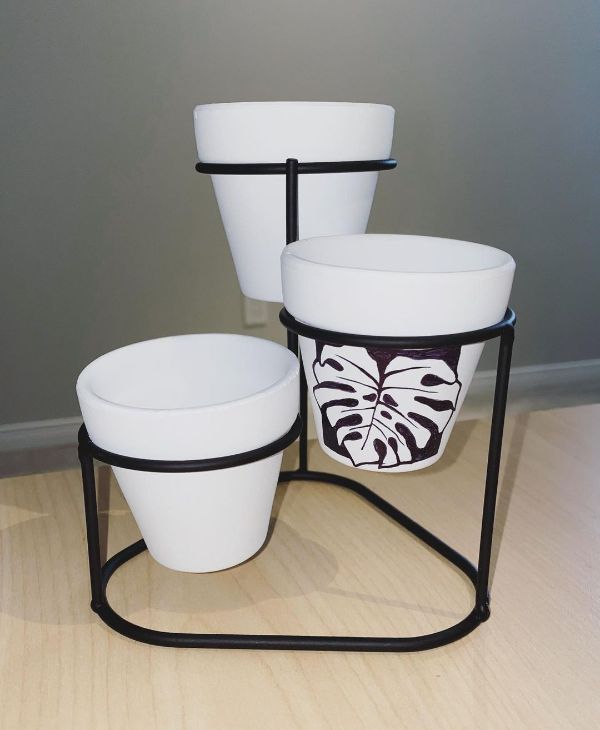
Pros:
- They are available in a variety of distinctive styles and hues, ranging from basic colors to artistic finishes. You won’t be able to go wrong with one to complement your indoor or outdoor decor
- Just like clay, they act as a heat sink for plants
- They, like clay, protect plants from unexpected temperature fluctuations
They’re a great alternative for folks who want to submerge their Monstera because they don’t wick water
Cons:
- They do not allow air to get through their walls in order for these plants to flourish
- They are not an ideal solution for folks who have an overwatering problem since they do not wick water away
- These ceramic pots are delicate, which means they will break if dropped
Make sure the glazed ceramic pot you choose has holes. If not, drill some holes. It will perform well both indoors and outdoors and will look excellent if you are concerned with aesthetics. You can discover stylish ones that will go with any indoor or outdoor décor.
It may be an ideal solution for people who want to keep their plants underwater. Remember to water your Monstera properly, though! It is possible to use a plastic container as a cachepot, but you’ll need to punch holes in it.
Metal planters
Another wonderful planter for your Monstera is constructed of aluminum or steel and finished in a variety of ways, including galvanized. Various sizes, shapes, colors, and patterns will be available to choose from while creating them.
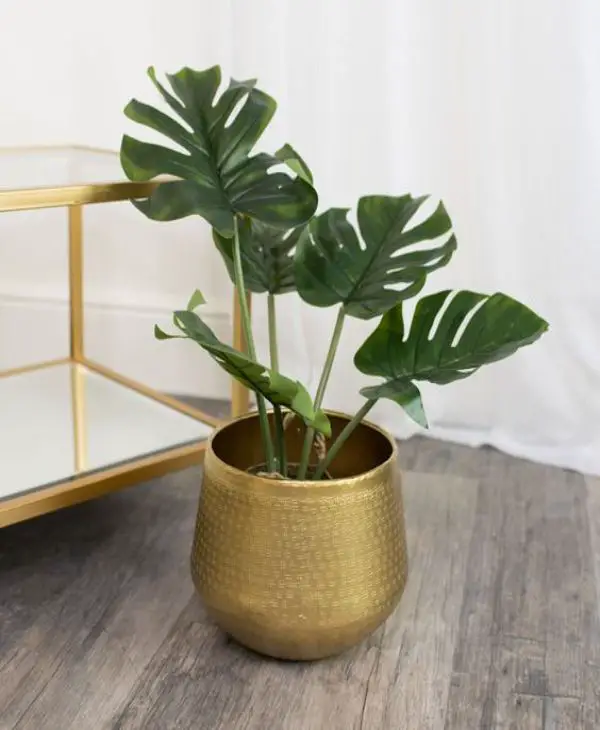
In terms of cache containers, they’re an excellent option because of their aesthetic value.
Pros:
- They’ll give your yard or house a distinctive look that guests won’t expect. They have a rustic look or maybe a faded patina that you will like
- Metal pots may rust or corrode, but they are generally quite strong and will not readily break
- It’s simple to reuse. With a few adjustments, you may utilize old metal containers as planters
Cons:
- Some metal coatings may be damaged by fertilizer salts
- Planters made of metal can become extremely hot or cold, especially if they are left outside
- These planters, particularly ones containing lead, may pose health dangers to your plant. It’s also possible for galvanized ones to leak zinc into the soil, which is bad for your plant Chlorosis, stunted growth, curled leaves, and leaf tip death are all symptoms of this disease
- Non-porous
- Some of them weigh a lot
They are long-lasting and have a rustic appearance. It is suitable for usage both indoors and outdoors. However, be certain that these pots are suitable for your plants. Lead may be present in older ones. Also, steer clear of galvanized.
Concrete planters
Concrete may also be used as a Monstera planter. You can buy them in a wide variety of stunning colors and forms, making them one of the most eye-catching container options.
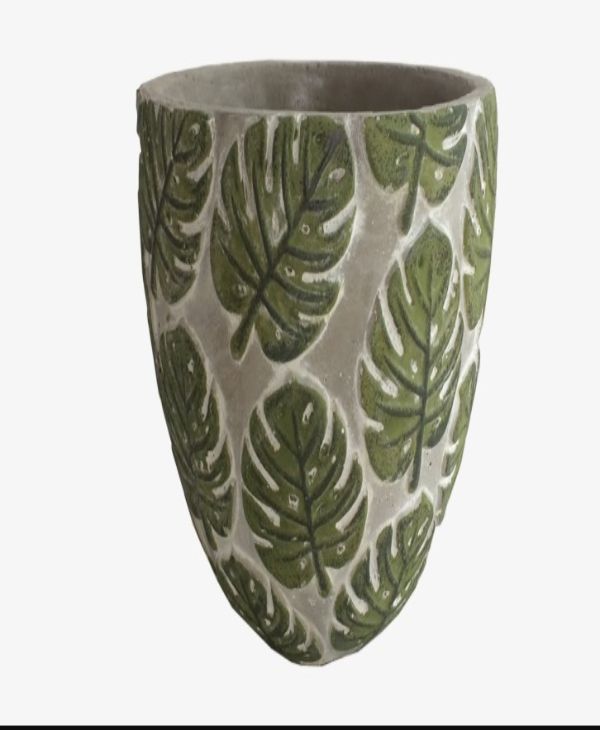
Pros:
- They are strong and long-lasting. Concrete planters are resistant to wind and rain and will survive for decades
- The roots of your plant will be protected from extremes of temperature by these pots, which, like ceramic pots, provide insulation
- Heavy, solid, and capable of supporting even the largest Monstera plants without swaying
- If you blend the colors into the concrete before pouring it into a mold, they may keep their color
- They are permeable, just like clay pots. As a result, they will permit some water and air to enter through their wall
Cons:
- If you’re a fan of rearranging your Monstera, you’ll have a difficult time moving them about. Also, if you utilize them for tale development, keep in mind their weight
- Mineral salts from the soil can cause stains on concrete planters
- Moss growth is a possibility
- Concrete’s high lime concentration might alter the pH of the soil, which could be detrimental to your Monstera’s growth
Planters made of concrete are rather hefty. If you don’t plan to transfer your plants, you’ll need to purchase a new one. These pots are ideal for use outside, particularly if you have a large Monstera plant. They are an excellent alternative for those who over-water their plants.
Self-watering pots
These are pots with a water reservoir and a wicking mechanism, not a kind. You’ll fill the reservoir with water, which will gently seep into the potting mix.
They’re a great option for folks who have trouble watering their plants or who have a busy schedule. They’ll figure out if you’ve been overwatered or if you’ve been underwatered.
The best type of pot for Monstera
Followed by ceramic and plastic. Weigh the advantages and drawbacks carefully to determine if the one you choose meets your requirements. If watering is an issue, consider a self-watering pot.
Suggestions for choosing the best planter for Monstera
Choosing the right pot size
If a tree is in a too-large pot, the soil dries slowly, which will make your plant susceptible to root rot. On the contrary, the tree is too big for the pot, falling quickly. In a small pot, the soil dries so fast that it will challenge you with the need to water the plant regularly. Your plant may grow sluggishly. What size pot for Monstera is the question you should answer first. An ideal pot has the same size in which it fits. When the plant is already larger than its current pot, transfer to a pot 2-4 inches larger in diameter. Choose a larger, the best type of pot for Monstera for fast-growing plants.
Why are little pots bad?
A tiny container will confine your plant’s roots, preventing it from absorbing enough nutrients and water from the soil. As a result, it will grow slowly, become lanky, wilt/droop, have yellow leaves, brown tips and borders on leaves, shed leaves, and so on. Roots coming from drainage holes are a solid indicator that your plant is rootbound.
Why are huge pots bad?
Some individuals succumb to the lure of purchasing an enormous Monstera pot in the goal of not having to repot their Monstera for a long time. Never, ever do this. It will result in overwatering since the plant will take a long time to use all of the water in the huge planter.
Is there an ideal size?
No, there is no ideal Monstera pot size. Everything is determined by the size of your plant. Select one that is 2-3 inches larger than the existing one.
Deciding on materials
Plant containers are built from a variety of materials, as you shall see above. Each has benefits, drawbacks, and appropriateness.
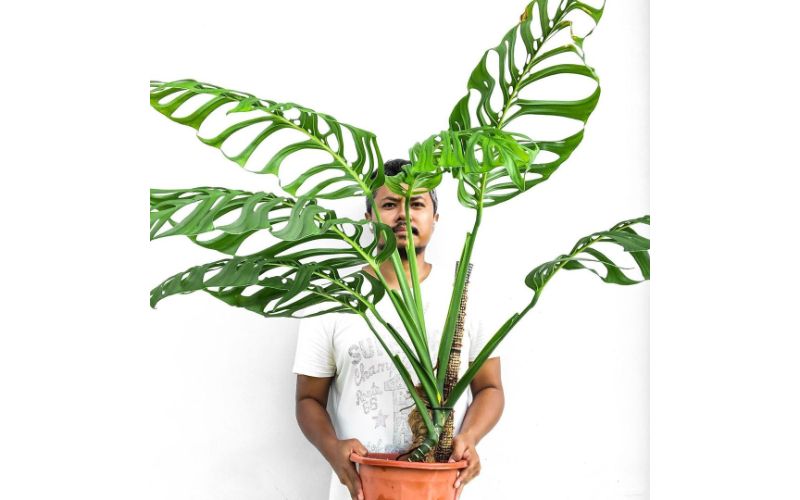
best pot for Monstera with a plastic pot that keeps a Monstera’s roots cooler
Due to your personal style
Planters and pots come in a variety of styles, shapes, colors, and materials. You should choose one that complements your style and décor. What counts here is personal preference and taste.
Where will you put it?
Some are intended for indoor use, while others are intended for outdoor use. Consider this while selecting a Monstera pot. Everything will become evident when we examine the many sorts.
Weight
Weight is an important aspect that is linked to the material. Heavy pots are difficult to move and are not a suitable option if you enjoy moving your plants.
Your watering practices
Pots can be porous or non-porous. Porous walls enable water and air to pass through, but non-porous walls do not.
Those who overwater their plants require a porous one, while those who underwater require a non-porous one.
Related Post: When Monstera leaves split? (6 Ways to Improve leaf splitting)
Some other notes when you choose to buy pots for Monstera
Consider the pot’s drainage hole
Most houseplants won’t thrive in standing water. So your pot needs a drainage hole in the bottom to allow water out and air in. If you want to buy a pot without drainage holes for decorative purposes. Please use it as an outer cushion cover. Keep the pot in which the plant is growing. Put an actual plastic or terracotta pot in a pretty box. A cushion pot does not need a drainage hole. However, it should be large enough to accommodate a suitable drainage basin inside.
Consider the cost and weight of the pot
When you buy a pot, you also need to consider the price of the best pot for Monstera. Because the tree will continuously grow and develop, you need to change the appropriate pot for the tree every 2-3 years. You may not need to buy too expensive pots. Just be suitable for your budget. Besides, to facilitate plants, such as helping them get the necessary light, you need a lightweight pot to quickly when moving. But if the pot is too light, the durability the pot is not high. So you should pay attention to choosing one appropriately.
Consider the color of the potted plant
A pot occupies a small space in the house. The color of the pot is in some primary colors, such as white and brown. However, the color of the pot also dramatically affects the context of the indoor space. You should choose the right color to highlight it. You also pay attention to the location of the indoor plants to ensure the light for the plants to grow.
Above is a guide to help you choose the best pot for Monstera. If you love to learn more about the best ways to care for this plant, keep with us our articles on the web: DIG Nursery to read articles on how to grow and care for the plant.

